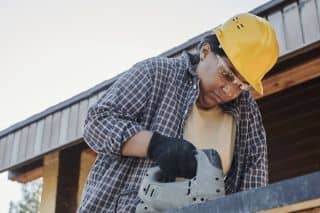
www.buildingsandcities.org/insights/commentaries/the-role-governments-providing-thermal.html
Governments' Role in Providing Thermal Adequacy

How can governments advance adaptive solutions for keeping cool during hot weather?
Brian Dean and Elizabeth Wangeci Chege (Sustainable Energy for All) respond to the Buildings & Cities special issue Alternatives to Air Conditioning and explain why thermal comfort is not only a construction industry problem to solve but needs to be placed in the policy agenda on global warming. Thermal adequacy is still not understood as an essential need for human survival and that governments have an essential role.
SEforALL's (2023) Chilling Prospects research series found that 1.2 billion people in poor rural and urban settings are at high risk because they lack access to cooling. These risks are growing, with 28 million more people at high risk over the last year. The research series further finds that 2.47 billion lower-middle income people are at medium risk due to the use of used or lowest first cost inefficient and unsustainable cooling technologies and another 1.36 billion middle income people at low risk but can afford more efficient and sustainable cooling solutions. This represents a substantial population in need of affordable, efficient and climate-friendly cooling solutions.
In urban areas, the effects of urban poverty and urban heat islands produce a consistently increasing risk and an opportunity with both better design of the built environment, infrastructure, and the infusion of nature-based solutions.
National, sub-national and local governments are critical stakeholders for provision of access to adequate thermal comfort for its citizens. Greater alignment among governance structures, both between national and local policies (vertical integration) and between local sectoral institutions (horizontal integration) plays an essential role in meeting environmental, economic and social objectives simultaneously (IEA 2016). In the New Urban Agenda, Habitat III helped to systematize the alignment between cities and towns and national planning objectives in their role as drivers of national economic and social development.
Minimising the effects of higher temperature on health requires both prevention of and adaptation to a changing climate. Leaders must provide transformative regulatory frameworks, policy, and investment to ensure sustainable climate change mitigation and adaptation and ensure that thermal comfort and ultimately the health dimensions of heat can no longer be overlooked. Key actions for governments on adequate, affordable thermal comfort include to drive engagement with community-based, non-profit, and civil society organizations, human-rights groups and local communities to advance adoption of solutions and contribute to climate and development goals. Governments can consider four levels of action:
1. Global. The next UNFCCC Conference of Parties, COP28 to be held in UAE, is a prime opportunity for national governments to create action on thermal adequacy through Nationally Determined Contributions, national cooling action plans, and as part of an adaptation strategy. The IPCC (2022) Sixth Assessment Report Working Group II technical summary identifies passive cooling solutions as ecosystem-based adaptation measures that can reduce the climatic risk to people. Additionally, the IPCC (2023) cites that green/natural and blue infrastructure such as urban forestry, green roofs, ponds and lakes, and river restoration can mitigate climate change through carbon uptake and storage, avoided emissions, and reduced energy use while reducing risk from extreme events such as heatwaves, heavy precipitation and droughts, and advancing co-benefits for health, wellbeing and livelihoods while urban greening can provide local cooling.
2. National. Develop national cooling action plans that are robust, data driven and implementable These can provide focus on thermal comfort pathways for comprehensive action to reduce energy related emissions from cooling and address the UN Sustainable Development Goals. Strong national cooling policies and legal frameworks can promote and implement urban spatial planning requirements that prioritise response to climatic design. Rethinking building codes, development codes and spatial planning standards would improve decision-making and protect vulnerable populations in particular.
3. Community. Urban planning has consistently been flagged as one of the critical adaptive actions that can help provide thermal comfort through passive means. Government procurement programs can drive investment in solutions proven to be effective. Join and collaborate with technology and nature challenges and competitions like Beat the Heat: Nature for Cool Cities Challenge (Cool Coalition 2022) to unleash the cooling power of nature and catalyze nature based solutions implementation.
4. Individuals. Appoint Chief Heat Officers to unify local government's responses to extreme heat while accelerating sustained heat resilience for people. Adopt and lead by example on consumer choice and behaviour change programmes that can further support and empower individuals to have better purchasing habits, energy efficient behavior and understanding that thermal comfort is their human right.
Across these four levels of action, many solutions can deliver thermal comfort if they are available in the market. Research, development and deployment support from governments would enhance the availability of local thermal comfort solution technologies and service providers. Achieving thermal comfort sustainably should start with solutions that have a range of benefits, like nature-based solutions, and then solutions that do not use operational energy and finally solutions that use renewable energy. These include:
• Nature based solutions (e.g. parks, trees, ponds,
fountains)
Trees and vegetation can lower surface
and air temperatures by 11-25 oC compared to unshaded surfaces (US
EPA 2022). These should be planted in strategic locations around buildings or
to shade pavements streets and car parks.
• Reflective paints
A passive cooling solution on
building surfaces that can improve comfort and reduce the demand for cooling
energy. The Million Cool Roof Challenge found that replacing a dark roof with a white roof can
cool the building cost effectively across a range of building types and locations.
• Shading
A range of shading techniques can be employed
to reduce solar heat gain and glare, such as external moveable shading (BEEP n.d.) to keep the heat outside the buildings, internal shading and
curtains that can keep heat in during the winter and keep the heat out in the
summer, or nature as shading, such as trees or vines.
• Air seal any uncontrolled airflow
Air quality and
thermal comfort are closely linked to controlling airflow and reducing convective
heat gain through building cracks and holes.
• Natural ventilation
Better building and community
design can induce both stack and cross natural ventilation or support
displacement mechanical cooling. Each of these reduces energy use and can
increase thermal comfort and air quality.
• Zoning and spatial design
Better space planning and
adaptive personal comfort controls within a building can limit the need for
cooling by creating comfort zones or individual cooling.
• Windows and insulation
Well insulated windows, walls
and roofs can limit both radiative and conductive heat gain.
• Low energy fans
When passive cooling
approaches are not achieving the comfort needed, the next step is to use high
efficiency fans, ventilators and evaporative coolers.
• Renewable energy powered super-efficient mechanical
cooling or district cooling
If further comfort is needed, sustainable cooling can
be delivered with renewable energy powered mechanical cooling and no global
warming potential refrigerants.
National governments and regulators can play an important role to help bring these sustainable thermal comfort solutions to market - while creating new jobs, improving lives and advancing climate action.
References
BEEP. (n.d.). External moveable shading systems. Indo-Swiss Building Energy Efficiency Project (BEEP). https://www.beepindia.org/external-moveable-shading-systems-emsys/
Challenge Works (2022). Million cool roofs challenge. https://challengeworks.org/challenge-prizes/million-cool-roofs-challenge/
Cool Coalition. (2022). Beat the heat, nature for cool cities challenge, https://coolcoalition.org/pilot-projects/nature-for-cool-cities-challenge/
SEforAll. (2023). Chilling Prospects. https://www.seforall.org/impact-areas/data-and-evidence/chilling-prospects-series
IEA. (2016). Energy Technology Perspectives 2016 - Analysis. International Energy Agency. https://www.iea.org/reports/energy-technology-perspectives-2016
IPCC. (2022). Climate Change 2022: Impacts, Adaptation and Vulnerabilities. Working Group II contribution to the Sixth Assessment Report of the Intergovernmental Panel on Climate Change. Technical summary. https://www.ipcc.ch/report/ar6/wg2/downloads/report/IPCC_AR6_WGII_TechnicalSummary.pdf
IPCC (2023). Synthesis Report of the IPCC Sixth Assessment Report (AR6): Longer Report. https://www.ipcc.ch/report/ar6/syr/downloads/report/IPCC_AR6_SYR_LongerReport.pdf
US EPA. (2022). Using trees and vegetation to reduce heat islands. United States Environmental Protection Agency. https://www.epa.gov/heatislands/using-trees-and-vegetation-reduce-heat-islands
Latest Peer-Reviewed Journal Content
A living lab approach to co-designing climate adaptation strategies
M K Barati & S Bankaru-Swamy
Mediation roles and ecologies within resilience-focused urban living labs
N Antaki, D Petrescu, M Schalk, E Brandao, D Calciu & V Marin
Negotiating expertise in Nepal’s post-earthquake disaster reconstruction
K Rankin, M Suji, B Pandey, J Baniya, D V Hirslund, B Limbu, N Rawal & S Shneiderman
Designing for pro-environmental behaviour change: the aspiration–reality gap
J Simpson & J Uttley
Lifetimes of demolished buildings in US and European cities
J Berglund-Brown, I Dobie, J Hewitt, C De Wolf & J Ochsendorf
Expanding the framework of urban living labs using grassroots methods
T Ahmed, I Delsante & L Migliavacca
Youth engagement in urban living labs: tools, methods and pedagogies
N Charalambous, C Panayi, C Mady, T Augustinčić & D Berc
Co-creating urban transformation: a stakeholder analysis for Germany’s heat transition
P Heger, C Bieber, M Hendawy & A Shooshtari
Placemaking living lab: creating resilient social and spatial infrastructures
M Dodd, N Madabhushi & R Lees
Church pipe organs: historical tuning records as indoor environmental evidence
B Bingley, A Knight & Y Xing
A framework for 1.5°C-aligned GHG budgets in architecture
G Betti, I Spaar, D Bachmann, A Jerosch-Herold, E Kühner, R Yang, K Avhad & S Sinning
Net zero retrofit of the building stock [editorial]
D Godoy-Shimizu & P Steadman
Co-learning in living labs: nurturing civic agency and resilience
A Belfield
The importance of multi-roles and code-switching in living labs
H Noller & A Tarik
Researchers’ shifting roles in living labs for knowledge co-production
C-C Dobre & G Faldi
Increasing civic resilience in urban living labs: city authorities’ roles
E Alatalo, M Laine & M Kyrönviita
Co-curation as civic practice in community engagement
Z Li, M Sunikka-Blank, R Purohit & F Samuel
Preserving buildings: emission reductions from circular economy strategies in Austria
N Alaux, V Kulmer, J Vogel & A Passer
Urban living labs: relationality between institutions and local circularity
P Palo, M Adelfio, J Lundin & E Brandão
Living labs: epistemic modelling, temporariness and land value
J Clossick, T Khonsari & U Steven
Co-creating interventions to prevent mosquito-borne disease transmission in hospitals
O Sloan Wood, E Lupenza, D M Agnello, J B Knudsen, M Msellem, K L Schiøler & F Saleh
Circularity at the neighbourhood scale: co-creative living lab lessons
J Honsa, A Versele, T Van de Kerckhove & C Piccardo
Positive energy districts and energy communities: how living labs create value
E Malakhatka, O Shafqat, A Sandoff & L Thuvander
Built environment governance and professionalism: the end of laissez-faire (again)
S Foxell
Co-creating justice in housing energy transitions through energy living labs
D Ricci, C Leiwakabessy, S van Wieringen, P de Koning & T Konstantinou
HVAC characterisation of existing Canadian buildings for decarbonisation retrofit identification
J Adebisi & J J McArthur
Simulation and the building performance gap [editorial]
M Donn
Developing criteria for effective building-sector commitments in nationally determined contributions
P Graham, K McFarlane & M Taheri
Join Our Community

The most important part of any journal is our people – readers, authors, reviewers, editorial board members and editors. You are cordially invited to join our community by joining our mailing list. We send out occasional emails about the journal – calls for papers, special issues, events and more.
We will not share your email with third parties. Read more



Latest Commentaries
COP30 Report
Matti Kuittinen (Aalto University) reflects on his experience of attending the 2025 UN Conference of the Parties in Belém, Brazil. The roadmaps and commitments failed to deliver the objectives of the 2025 Paris Agreement. However, 2 countries - Japan and Senegal - announced they are creating roadmaps to decarbonise their buildings. An international group of government ministers put housing on the agenda - specifying the need for reduced carbon and energy use along with affordability, quality and climate resilience.
Building-Related Research: New Context, New Challenges
Raymond J. Cole (University of British Columbia) reflects on the key challenges raised in the 34 commissioned essays for Buildings & Cities 5th anniversary. Not only are key research issues identified, but the consequences of changing contexts for conducting research and tailoring its influence on society are highlighted as key areas of action.